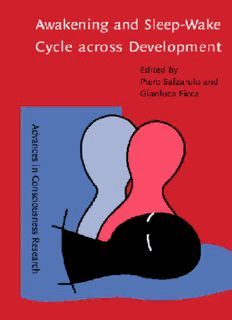
Awakening and Sleep-Wake Cycle Across Development (Advances in Consciousness Research) PDF
Preview Awakening and Sleep-Wake Cycle Across Development (Advances in Consciousness Research)
AwakeningandSleep-WakeCycleacrossDevelopment Advances in Consciousness Research Advances in Consciousness Research provides a forum for scholars from differentscientificdisciplinesandfieldsofknowledgewhostudyconsciousness initsmultifacetedaspects.ThustheSerieswillinclude(butnotbelimitedto) thevariousareasofcognitivescience,includingcognitivepsychology,linguis- tics, brain science and philosophy. The orientation of the Series is toward developingnewinterdisciplinaryandintegrativeapproachesfortheinvestiga- tion, description and theory of consciousness, as well as the practical conse- quencesofthisresearchfortheindividualandsociety. SeriesB:Researchinprogress.Experimental,descriptiveandclinicalresearch inconsciousness. Editor MaximI.Stamenov BulgarianAcademyofSciences EditorialBoard DavidChalmers,UniversityofArizona GordonG.Globus,UniversityofCaliforniaatIrvine RayJackendoff,BrandeisUniversity ChristofKoch,CaliforniaInstituteofTechnology StephenKosslyn,HarvardUniversity EarlMacCormac,DukeUniversity GeorgeMandler,UniversityofCaliforniaatSanDiego JohnR.Searle,UniversityofCaliforniaatBerkeley PetraStoerig,UniversitätDüsseldorf †FranciscoVarela,C.R.E.A.,EcolePolytechnique,Paris Volume38 AwakeningandSleep-WakeCycleacrossDevelopment EditedbyPieroSalzaruloandGianlucaFicca Awakening and Sleep-Wake Cycle across Development Edited by Piero Salzarulo UniversityofFlorence Gianluca Ficca SecondUniversityofNaples JohnBenjaminsPublishingCompany Amsterdam(cid:1)/(cid:1)Philadelphia TM ThepaperusedinthispublicationmeetstheminimumrequirementsofAmerican 8 NationalStandardforInformationSciences–PermanenceofPaperforPrinted LibraryMaterials,ansiz39.48-1984. LibraryofCongressCataloging-in-PublicationData Awakeningandsleep-wakecycleacrossdevelopment /editedbyPieroSalzarulo,Gianluca Ficca. p. cm.(AdvancesinConsciousnessResearch,issn1381–589X;v.38) Includesbibliographicalreferencesandindex. 1.Sleep-wakecycle.2.Developmentalneurobiology.I.Salzarulo,Piero.II.Ficca, Gianluca.III.Series. QP84.6.A935 2002 612.8’21--dc21 2002276248 isbn902725158(cid:2)4(Eur.)/158811174(cid:2)1(US)(Pb;alk.paper) ©2002–JohnBenjaminsB.V. Nopartofthisbookmaybereproducedinanyform,byprint,photoprint,microfilm,orany othermeans,withoutwrittenpermissionfromthepublisher. JohnBenjaminsPublishingCo.·P.O.Box36224·1020meAmsterdam·TheNetherlands JohnBenjaminsNorthAmerica·P.O.Box27519·Philadelphiapa19118-0519·usa Table of contents Awakening:Whichchangesacrossdevelopment? PieroSalzarulo 1. Methodologicalissues Developmentofwakefulness:Re-awakeninganeglectedtopic BrianHopkins Methodologicalissuesinthestudyofarousalsandawakenings duringsleepinthehumaninfant MarieJ.Hayes Awakeningfrominfants’sleep:Someremarksondefinitions, methodologyandresearchissues GianlucaFicca Arousalsininfantsduringthefirstyearoflife: Argumentfornewdefinitionsandcriteria RonaldL.Ariagno,MajidMirmiran,andRobertA.Darnall 2. Trendsofsleep-wakecycleandawakeningsacrossthedevelopment Spontaneousarousalandawakeninginpretermandfull-terminfants LiliaCurzi-Dascalova,HeinzZotter,RonaldL.Ariagno,and MajidMirmiran Awakeningandsleep-wakecycleininfants IginoFagioli,GianlucaFicca,andPieroSalzarulo Awakeningsinschoolagechildren OlivieroBruni,S.Miano,E.Verrillo,S.Galiffa,andS.Ottaviano Tableofcontents 3. Physiologicalandenvironmentalinfluencesonawakenings Awakenings,sleep-wakecycleandthermalenvironmentinneonates VéroniqueBach,FrédéricTelliez,PierluigiLenzi,KarenChardon, AndréLeke,andJean-PierreLibert Timepatternanalysisofactivity-restrhythmsinfamilies withinfantsusingactigraphy KatharinaWulffandRenateSiegmund Theeyesofparentsoninfantsawakening FiorenzaGigantiandMonicaToselli Mother-infantrelationshipasamodulatorofnightwaking AnatScher 4. Clinicalcontexts Sleepfragmentationandawakeningduringdevelopment: Insightsfromactigraphicstudies AviSadeh Arousalsandawakeningsininfancy:Evaluationforclinicalcontext MarieFrançoiseVecchieriniandYvonneNavelet Arousalresponsestohypercapniaandhypoxiaininfants andchildren ClaudeGaultier Thescoringofarousalsininfants:Areportontheongoingwork ofthePediatricWake-UpClub JosèGroswasser,PatriciaFranco,T.Simon,SoniaScaillet, FilomenaValene,AlainDeBroca,andAndréKahn Indexofnames Indexofterms Awakening Which changes across development? PieroSalzarulo DepartmentofPsychology,UniversityofFlorence Sleep-wakefulnessrhythmundergoesimpressivechangesacrossdevelopment: both sleep and wakefulness change not only in duration and temporal orga- nization,butalsoinphysiologicalandbehaviouralqualities.Allthesefeatures have been extensivelydescribed in the last decades (for reviewssee Salzarulo & Fagioli, 1999; Curzi & Challamel, 2000).The trendwith developmentcon- sistsintheconsolidationofsleepepisodesoflongerdurationduringthenight and in the lengthening of wakefulness episodes during the day. Within this frame it is easily understandablethat awakening is a crucial event.Neverthe- less, contributions on this topic are relatively scarce. They come from differ- entstreamsofinvestigation,sometimeswithdifferentterminologies.Thereare experimental researches on normal babies speaking about ‘awakening’, clini- calapproachesreferringto‘nightwaking’,andinvestigationsaboutrespiratory pathologieswhich oftenusetheterm‘arousal’(seeforinstanceGroswasseret al.contribution,thisvolume). It is important to examine the conceptual frame which underlieseach of these domains; there are methodological and epistemological aspects which needtobeunderscored. Experimental research showed frequency and age distribution in normal infants and was also intended to shed light on the processes which lead to awakening. Awakening was characterized by the appearance of behavioural manifestations of wakefulness (for a review see Hayes and Fagioli et al., this volume). Nightwakingisaconceptmainlyusedinpediatricandpsychologyprac- ticewhichisrelatedtoanexcessivefrequencyand,aboveall,durationofwake- fulness during the night as a consequenceof a single or of multiple awaken- PieroSalzarulo ings. While the causes are multiple (see Messer & Richards, 1993 for a re- view), emphasis is put on practical approaches to solve this disturbing event forfamilies. Athirdapproachcomesmainlyfromthefieldofrespiratorydisturbances and uses a differentterm, ‘arousal’, which is often considered an ‘equivalent’ of awakening. Some authors, as Thach & Lijowska (1996), speak about ‘full arousal’ to indicate ‘awakening’. In fact, this is an intriguing problem which deservessomecommentsandshouldbeclarified.Theterm‘arousal’,notonly in the fieldof respiratorydisturbancesduring development,oftenindicatesa changeinthedepthofsleep,which resumes(infactitneverdisappeared)af- terashorttimeintervalmeasuredinseconds(ASDA,1992).Theseshorttime eventshavebeeninterpretedassignsofphysiologicalactivation.Toclarifythe situation, a main research challenge could be to compare awakening features witharousalfeatures,asfarastheprocessesleadingtoandtheirconsequences areconcerned. Besidesthedefinitionofthemainfeaturescharacterisingeach(arousaland awakening),thecontinuitybetweenthetwoisofinterest(atopicevokedalso byHayesandFiccainthisvolume).Istheawakeningthetransformationofthe arousal?Isarousalanecessaryeventprecedingawakening?Thach &Lijowska (1996),forinstance,considersighsand‘trashing’(i.e.motorevents),signsof ‘arousal’necessarilyprecedingthe‘fullarousal’(i.e.‘awakening’).Chughetal. (1996),speakingabouttheadult,areinfavourofacontinuumbetweenarousal andawakening,whereasScheretal.(1992),instudiesonbabies,pinpointthe markeddifferencebetweenthemechanismsregulatingthetwo.Afurtherques- tion:isarousalanexpressionofatemporaryshortinstabilityoftheCNSactiv- ity,whileawakeningisa‘true’changeofstate?Evidencecouldcomealsofrom thestudyofthedevelopmentaltrendsofbothevents:doarousaladawakening sharethesametrends(i.e.changewithage)?Ifnot,thiscouldbeanadditional argumenttoseparatethem. Itisimportanttorememberthatawakeningisatransitionbetweentwodif- ferentmodesofCNSfunctionning(Wolff,1984),facingeachother:sleepstate and wakefulness state. Time and modalities for passing the frontier (Garma, 1994) between these two blocks depend on several factors. First, the intrin- sic features of each ‘block’ which are linked to maturation. Then, the ability of the brain to reconstructa differentmode of activity, which consistsin the coordination of several physiological functions. The modalities of transition willbemoreorlesssmoothorabrupt,mainlyonthebasisofthesecapacities. Thetransitionprocessshouldhaveitstimecourse,whichhoweverisatpresent poorlyknown.AschematicsequencehasbeenproposedrecentlybyThachand Awakening:Whichchangesacrossdevelopment? Lijowska(1996),basedonrespiratoryandmotorevents;astudytakingintoac- counttheEEGactivitylevelprecedingspontaneousbehaviouralawakeningin infantsiscurrentlybeingperformedinourlab(Zampietal.,2001). Wakefulnessisimportantfordevelopment(Salzarulo&Fagioli,1995)and itscharacteristicschangewithage(Wolff,1984).Thus,speakingaboutawaken- ing,itseemsimportanttotakeintoaccountthekindofwakefulnesswhichfol- lowsasafunctionofage.Wakingupfordoingwhat?Justmove,lookaroundor interactwithobjects, persons?Therearepossibilitieswhich couldbeunavail- ableatthe beginningof life,andbecome a ‘choice’ onlylater.Modalitiesand processesoftransitionbetweensleepandwakefulnesscoulddependalsofrom therepertoireofwakefulnessthatinfantshaveattheirdisposalasexpressionof theirmaturationalstep(seeHopkinscontribution,thisvolume). Inthisbook,inordertodevelopsomeofthetopicsmentionedabove,we decidedtoincludeasetofpapersbycolleagueswhomadesignificantcontribu- tionsinthefieldandwhoareinvolvedinthestudyoftheprecociousdevelop- mentofbehaviouralandphysiologicalcomponentsofsleepandwakefulness. Thebook,mainlydealingwiththeissuesdiscussedduringameetingheld inFlorence,April14–15,2000(partiallysupportedbyUniversityofFlorence), isintendedtopresentcontributionsfrombothexperimentalandclinicalfields. Someofthepapersrefertoongoingdiscussionswithinaworkinggroup(Wake up club) on a developing consensus about criteria to define awakening and arousal. A first set of papers will raise methodological and theoretical problems dealing with awakening during development: in particular, the above men- tioned confrontation “arousal vs awakening”,which implies the construction andtheagreementoncriteriafordefiningeach(seeHayes,FiccaandAriagno contributions). Closely connected is the definition(s) of wakefulness(es) as a function of age, from its emergence to further qualitative and quantitative development(seeHopkinscontribution). Asecondgroupofpaperswilldescribechangesinawakeningfrompreterm infants to school-age children (see Curzi et al.; Fagioli et al.; Bruni et al. pa- pers).Theyincludebothsystematicdatacollecteduptonowandsuggestions oncriteriaaswellasonmodelswhichcouldaccountforprocessesinvolved.In anycase,theyareausefulbackgoundforcomparisonwithresultsobtainedin clinicalcontexts. Physiological and environmental factors influencing awakening will be consideredinathirdsection.Interactionwithtemperatureregulationisatopic of particular interest,since it raises the problemof the modalities of adapta- tiontoexternalconditionsandofmechanismsofbiologicalregulationatearly
